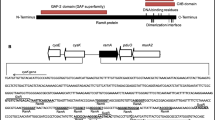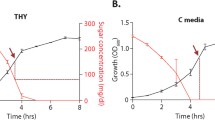Abstract
Ers is a pleiotropic transcriptional regulator in Enterococcus faecalis, an opportunistic bacterium. The authors have already shown that this protein is important for survival against oxidative stress and within macrophages as well as for survival of mice, and that Ers also is involved in the regulation of citrate and arginine metabolisms. The current study highlights the involvement of Ers also in the regulation of glycerol metabolism. The results suggest that EF0082, a known member of the Ers regulon encoding a major facilitator family transporter, may be able to transport glycerol. Moreover, the study demonstrates that Ers acts as a positive regulator of the glpKOF operon encoding glycerol kinase, glycerol-3-phosphate oxidase, and glycerol transport facilitator proteins.


Similar content being viewed by others
References
Abram F, Su WL, Wiedmann M et al (2008) Proteomic analyses of a Listeria monocytogenes mutant lacking sigmaB identify new components of the sigmaB regulon and highlight a role for sigmaB in the utilization of glycerol. Appl Environ Microbiol 74:594–604
Calamita G, Bishai WR, Preston GM et al (1995) Molecular cloning and characterization of AqpZ, a water channel from Escherichia coli. J Biol Chem 270:29063–29066
Giard J-C, Riboulet E, Verneuil N et al (2006) Characterization of Ers, a PrfA-like regulator of Enterococcus faecalis. FEMS Immunol Med Microbiol 46:410–418
Huycke MM (2002) Physiology of enterococci. In: Gilmore MS (ed) The enterococci: pathogenesis, molecular biology, antibiotic resistance. ASM Press, Washington, DC, pp 133–175
Jacob AE, Hobbs SJ (1974) Conjugal transfer of plasmid-borne multiple antibiotic resistance in Streptococcus faecalis var. zymogenes. J Bacteriol 117:360–372
La Carbona S, Sauvageot N, Giard J-C et al (2007) Comparative study of the physiological roles of three peroxidases (NADH peroxidase, Alkylhydroperoxide reductase and Thiol peroxidase) in oxidative stress response, survival inside macrophages, and virulence of Enterococcus faecalis. Mol Microbiol 66:1148–1163
Lin ECC (1976) Glycerol dissimilation and its regulation in bacteria. Ann Rev Microbiol 30:535–578
Ogier JC, Serror P (2008) Safety assessment of dairy microorganisms: the Enterococcus genus. Int J Food Microbiol 126:291–301
Paulsen IT, Banerjei L, Myers GSA et al (2003) Role of mobile DNA in the evolution of vancomycin-resistant Enterococcus faecalis. Science 299:2071–2074
Riboulet-Bisson E, Sanguinetti M, Budin-Verneuil A et al (2008) Characterization of the Ers regulon of Enterococcus faecalis. Infect Immun 76:3064–3074
Scortti M, Lacharme-Lora L, Wagner M et al (2006) Coexpression of virulence and fosfomycin susceptibility in Listeria: Molecular basis of an antimicrobial in vitro–in vivo paradox. Nat Med 12:515–517
Terzaghi BE, Sandine W (1975) Improved medium for lactic streptococci and their bacteriophages. Appl Microbiol 2:807–813
Yagi Y, Clewell DB (1980) Recombination-deficient mutant of Streptococcus faecalis. J Bacteriol 143:966–970
Yamada H, Kurose-Hamada S, Fukuda Y et al (1997) Quinolone susceptibility of norA-disrupted Staphylococcus aureus. Antimicrob Agents Chemother 41:2308–2309
Acknowledgments
The expert technical assistance of Annick Blandin was greatly appreciated. We thank A. Benachour, S. Gente, J-M. Laplace, V. Pichereau, A. Rincé, and N. Sauvageot for helpful discussions.
Author information
Authors and Affiliations
Corresponding author
Rights and permissions
About this article
Cite this article
Riboulet-Bisson, E., Hartke, A., Auffray, Y. et al. Ers Controls Glycerol Metabolism in Enterococcus faecalis . Curr Microbiol 58, 201–204 (2009). https://doi.org/10.1007/s00284-008-9308-4
Received:
Accepted:
Published:
Issue Date:
DOI: https://doi.org/10.1007/s00284-008-9308-4




